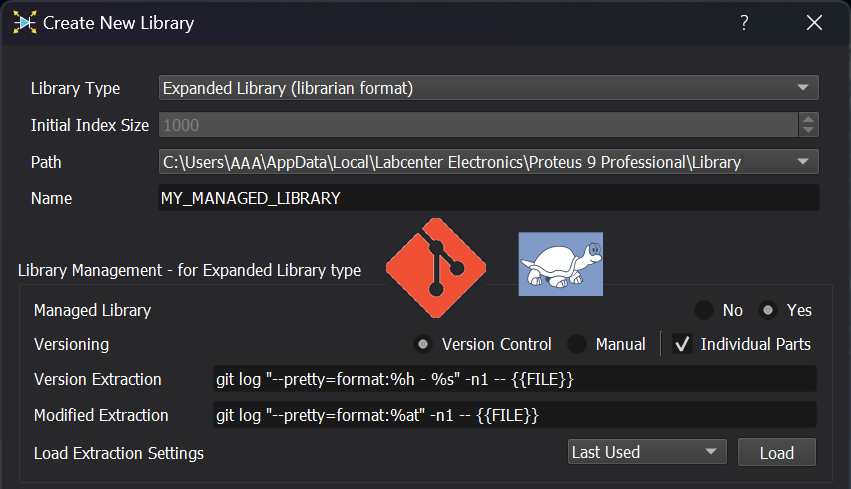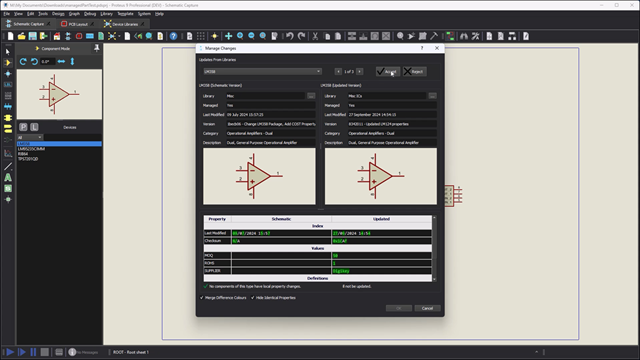Key Features
Turn on managed mode to take control over part usage and enforce a more restricted or quality controlled way of working. This is an approved library workflow that limits the available parts to those released by the librarian and provides auditing tools to check compliance.
- Restrict part pickers to only parts in released managed libraries.
- Prevent local changes to managed properties on the schematic.
- Use Library Manager to create, maintain and release managed libraries.
- Version libraries manually or use an external Git/SVN repository.
- Use the manage changes tool to compare placed parts to libraries.
- Verify only managed parts have been used with the Pre-production check.
The user switches Proteus into managed mode via a System setting. When picking parts this by default disables web import and restricts parts that can be picked to the set of managed libraries distributed by the librarian.
When parts are placed on the schematic any properties that the librarian has set to be managed (e.g. package, supplier, cost) will be read only on the schematic. This prevents locally placed components diverging from the managed libraries wherever it is deemed important by the librarian.
Users can optionally still make parts (or disable the picker filter and use web import) into their own libraries. This allows them to easily submit parts to the librarian for approval or to work on a prototype design while parts are being approved. The review and audit tools provide a failsafe and can be used to detect unmanaged parts in use before a production run.
When managed libraries are distributed from a repository workflow, users continue to pick from the released managed .LIB files; local editing of managed properties remains read-only, while any proposed new parts are created in user libraries and then submitted to the librarian for inclusion and versioning.
The librarian creates, maintains and releases managed libraries in Library Manager. Repository support is built in: once the local checkout path is added to System Settings, Library Manager exposes version control directly on the library, so the entire 'make/approve and release' workflow can be done without external tools
Expanded libraries are text-based and designed for version control. For repo-based libraries, Library Manager shows per-part status overlays (e.g., ToAdd, Locally Changed, Versioned, VersioningError) and provides a Version Control dialog with Changed Files and log message entry. Status info includes local and head revisions and can be refreshed on demand
Repository actions such as Update, Commit, Revert and Refresh are available directly from the Version Control button in Library Manager. When a managed library is released, Proteus also imports repository metadata such as commit hashes and log messages, so that the managed .LIB file includes traceable version information for each part.
Libraries can be versioned in one of two ways. The first is a manual versioning where the librarian simply sets a version number for the library as part of the release process. The second is to version the libraries using external repositories and the commit logs and hash/revision numbers will then be automatically imported back into Proteus as part of the library release process. One advantage of the repository method is that versioning is part specific as opposed to the manual method in which the entire library is versioned during release.
The reviewer is responsible for checking that the latest version of the library parts are present in the design. Normally, this would be as part of an engineering change or a board revision and the Manage Changes dialogue form will both display placed parts that diverge from the current libraries and allow a single click update/replace for each such part.
When managed libraries are sourced from a repository, the review process can also check that the design uses the correct revision of each part. Manage Changes compares the schematic or layout against the latest managed libraries and shows which parts differ from the released version. Repository metadata makes it clear whether a part is outdated, locally modified or unmanaged.
Another unwanted situation in the managed workflow is that unmanaged parts exist on the schematic/layout before a production run. This is almost certainly not intended and a dedicated test in the pre-production check will both warn and detail offending parts for manual replacement.
Video Walkthroughs
User Workflow
Working as a user with managed mode enabled.
Librarian Workflow (repo)
Creating and maintaining a set of managed libraries linked to an external repository
Reviewer Workflow
Updating managed parts after library changes and checking for unmanaged parts



